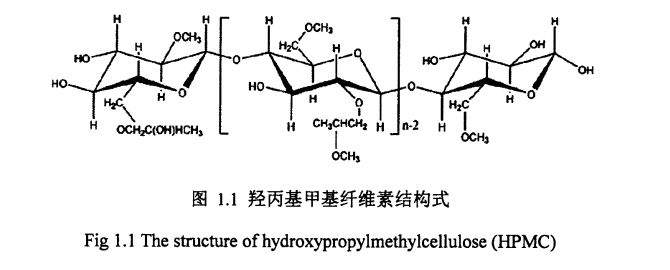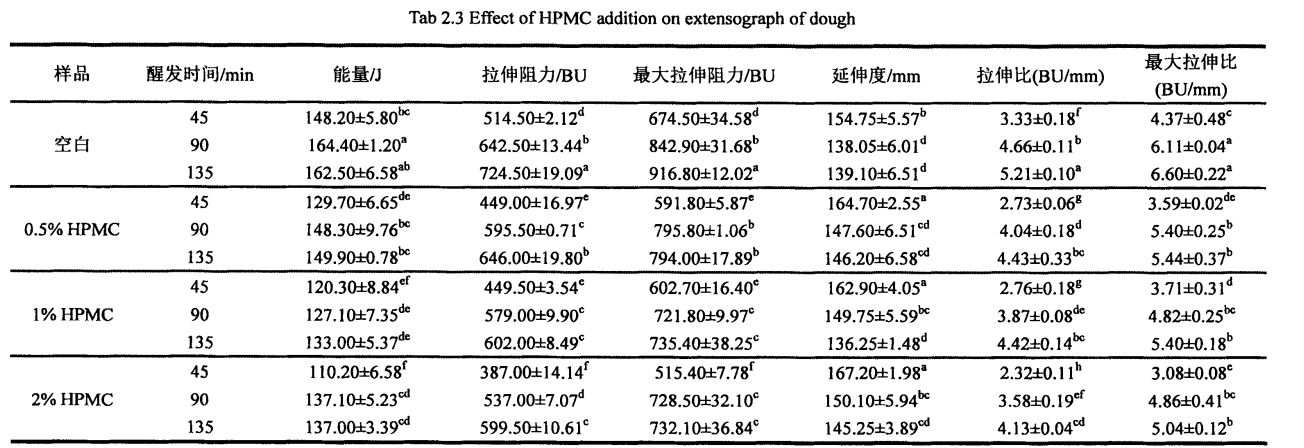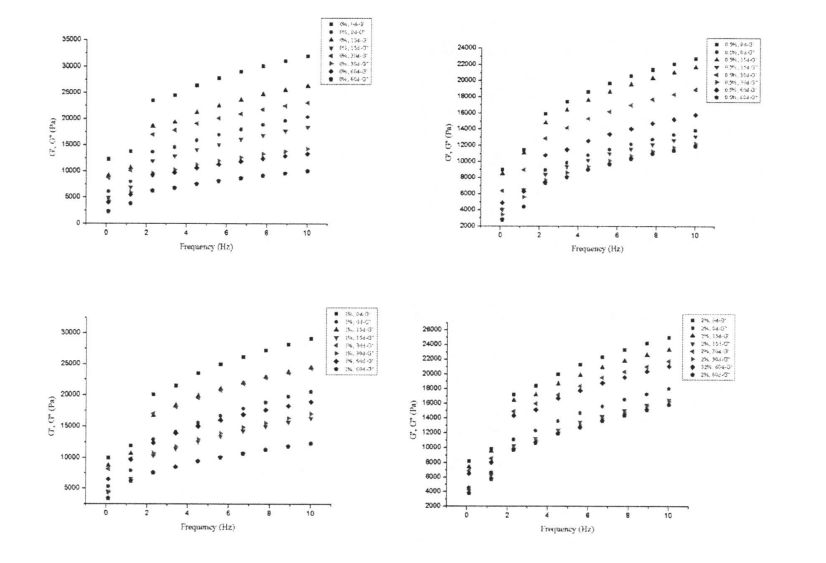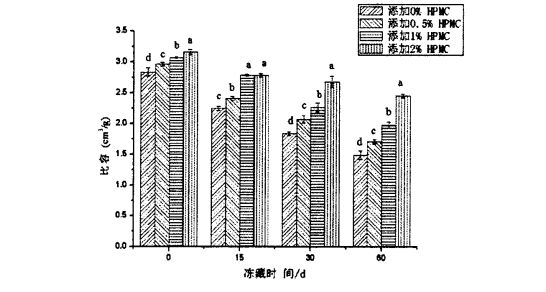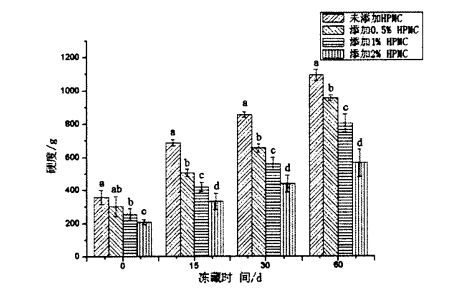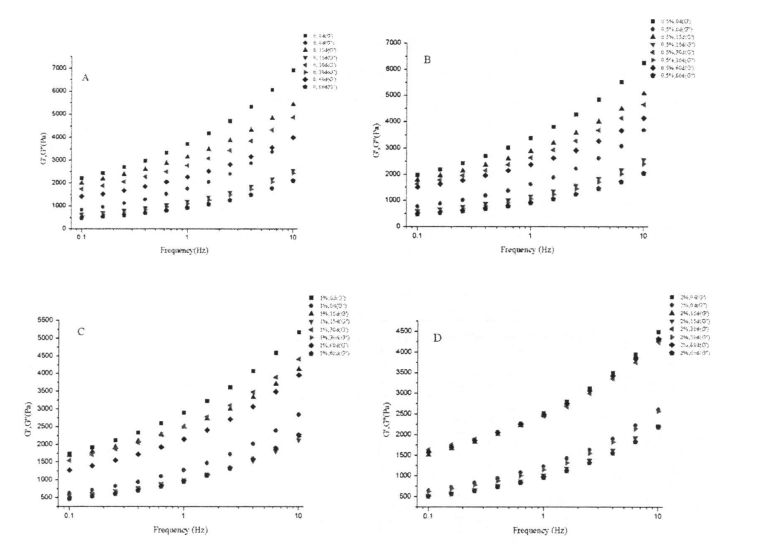Gluten gandum mangrupikeun dasar bahan pikeun struktur jaringan adonan adonan adonan. Experiments found that the addition of I--IPMC reduced the breakage of Yd and disulfide bonds between wheat gluten proteins during frozen storage. In addition, the results of low-field nuclear magnetic resonance and differential scanning the water state transition and recrystallization phenomena are limited, and the content of freezable water in the dough is reduced, thereby suppressing the effect of ice crystal growth on the gluten microstructure and its spatial conformation. Scanning electron microscope showed intuitively that the addition of HPMC could maintain the stability of gluten network structure.
Starch is the most abundant dry matter in dough, and changes in its structure will directly affect the gelatinization characteristics and the quality of the final product. X. The results of X-ray diffraction and DSC showed that the relative crystallinity of starch increased and the gelatinization enthalpy increased after frozen storage. Kalayan perunduran waktos beku, kakuatan anu sontak tanpa saluran wasiat HPCC parantos murteurik, sedengkeun excatries, sadayana paningkatan sacara signifikan. Salila waktos neundeun, distrib sareng grup kontrol, ku ningkat tambahan HPM, parobihan serangan kristal etén sareng gelatisize saeutik.
Daptar eusi
1.1 Current status of research at home and abroad………………………………………………………l
1.1.7 Mérroxsprophroplys Misil selulosa (hidrokmpopr tumpuk selulosa, IPMC) ........ Tipi 5
2.3 Experimental results and discussion…………………………………………………………………… . 11
3.2.2 Experimental apparatus ...........................................................................................................25
3.2.4 Experimental methods ....................................................................................................... 25
3.3.2 The effect of adding amount of HPMC and freezing storage time on the freezable moisture content (CFW) and thermal stability……………………………………………………………………. 30
3.3.3 Effects of HPMC addition amount and freezing storage time on free sulfhydryl content (C vessel) …………………………………………………………………………………………………………. . 34
4.1 Introduction .............................................................................................................................. . 44
4.2 Experimental materials and methods ................................................................................. 45
4.2.3 Experimental method ................................................................................................................45
4.3 Analysis and discussion ........................................................................................................... 48
4.3.1 Content of basic components of wheat starch ……………………………………………………. 48
4.3.3 Effects of HPMC addition and freezing storage time on the shear viscosity of starch paste………………………………………………………………………………………………………………………………………. 52
4.3.6 Effects of I-IPMC addition amount and frozen storage time on the thermodynamic properties of starch ………………………………………………………………………………………………………. . 57
Chapter 5 Effects of HPMC addition on yeast survival rate and fermentation activity under frozen storage conditions………………………………………………………………………………………………. . 62
5.1Introduction .................................................................................................................................... 62
5.2 Materials and methods ............................................................................................................ 62
5.2.1 Bahan ékspérimén sareng instrumen ...
5.2.2 Experimental methods . . . . . …………………………………………………………………………. 63
5.3 Results and Discussion ............................................................................................................... 64
5.3.3 The effect of adding amount of HPMC and freezing time on the content of glutathione in dough……………………………………………………………………………………………………………66. "
5.4 Chapter Summary ........................................................................................................................ 67
6.1 Conclusion ................................................................................................................................. . 68
6.2 Outlook .......................................................................................................................................... 68
Figure 1.1 The structural formula of hydroxypropyl methylcellulose………………………. . Kelas 6
Figure 2.4 The effect of HPMC addition and freezing time on the elasticity of steamed bread………………………………………………………………………………………………………………………………. . 20
Figure 3.1 The effect of HPMC addition and freezing time on the rheological properties of wet gluten…………………………………………………………………………………………………………………………. 30
Figure 3.2 Effects of HPMC addition and freezing time on the thermodynamic properties of wheat gluten………………………………………………………………………………………………………………. . 34
Figure 3.3 Effects of HPMC addition and freezing time on free sulfhydryl content of wheat gluten……………………………………………………………………………………………………………………………... . 35
Figure 3.7 The effect of HPMC addition and freezing time on the microscopic gluten network structure…………………………………………………………………………………………………………... . 43
Figure 4.1 Starch gelatinization characteristic curve ............................................................... 51
Figure 4.2 Fluid thixotropy of starch paste ................................................................................. 52
Figure 4.3 Effects of adding amount of MC and freezing time on the viscoelasticity of starch paste……………………………………………………………………………………………………………………... . 57
Figure 4.5 Effects of HPMC addition and freezing storage time on the thermodynamic properties of starch…………………………………………………………………………………………………………. . 59
Figure 5.2 The effect of HPMC addition and freezing time on the yeast survival rate…………………………………………………………………………………………………………………………………... . 67
Figure 5.3 Microscopic observation of yeast (microscopic examination) …………………………………………………………………………………………………………………………. 68
Table 2.1 The basic ingredient content of wheat flour…………………………………………………. 11
Table 3.2 Effects of I-IPMC addition amount and freezing storage time on the phase transition enthalpy (Yi IV) and freezer water content (e chat) of wet gluten………………………. 31
Méja 3.3 Balukaan jumlah adgas HPMC sareng waktos panyadia waktos dina suhu puncak (produk) dinyat termal anu termal tina Gluten Gluten Gluten Imut ... 33
Table 3.6 Effects of I-IPMC addition and freezing storage time on the surface hydrophobicity of wheat gluten……………………………………………………………………………………………. 41
Table 4.3 Effects of I-IPMC addition and freezing time on the shear viscosity of wheat starch paste…………………………………………………………………………………………………………………………. 55
Steamed bread refers to the food made from the dough after proofing and steaming. Salaku pasta pasta tradisional Cina, roti kukumbah ngagaduhan sajarah anu panjang sareng katelah Roti oruriah ". Because its finished product is hemispherical or elongated in shape, soft in taste, delicious in taste and rich in nutrients [l], it has been widely popular among the public for a long time. Ieu mangrupikeun sekik pokok nagara urang, khususna warga kalér. Carkasi kanggo sakitar 2/3 struktur dietét produk di kalér, sareng kira-kira 46% tina struktur diétamét tipung di nagara [21].
1)Development of new characteristic steamed buns. Through the innovation of steamed bread raw materials and the addition of functional active substances, new varieties of steamed breads have been developed, which have both nutrition and function. Established the evaluation standard for the quality of miscellaneous grain steamed bread by principal component analysis; Fu et a1. (2015) added lemon pomace containing dietary fiber and polyphenols to steamed bread, and evaluated the antioxidant activity of steamed bread; Hao & Beta (2012) studied barley bran and flaxseed (rich in bioactive substances) The production process of steamed bread [5]; Shiau et a1. (2015) ngaevaluasi pangaruh anu nambihan serat bubu bubu dina sipat anu rombologis sareng kualitas roti kukus [6].
3) Panaliti dina nyiapkeun adonan sarta henteu dikiring maca. Invalital pikeun pangaruh kaayaan prosés produksi roti dina kualitas kualitas sareng ngolah na optimasi; Liu changhong et al. (2009) showed that in the process of dough conditioning, process parameters such as water addition, dough mixing time, and dough pH value have an impact on the whiteness value of steamed bread. It has a significant impact on sensory evaluation. If the process conditions are not suitable, it will cause the product to turn blue, dark or yellow. The research results show that during the dough preparation process, the amount of water added reaches 45%, and the dough mixing time is 5 minutes, ~ When the pH value of the dough was 6.5 for 10 min, the whiteness value and sensory evaluation of the steamed buns measured by the whiteness meter were the best. Nalika Rolling adonan tilu-20 kali dina waktos anu sami, adonan dibersih pisan, lemes, (glastis; Nalika rasio gulung Ip: 1, pangkéng adonan ngagurilap, sareng kedip-kedip-épék ningkat [l ka; Li, et A1. (2015) explored the production process of compound fermented dough and its application in steamed bread processing [13].
6)Research on the application of new fermented bacteria and sourdough. Jiang, et A1. (2010) aplikasi chaetomium sp. fermented ngahasilkeun xylanase (kalayan tereramable) dina roti kukus [2l ';; Gerz, et A1. (2012) nganggo dua jinis baktéri asam laktina dina produk tipung fermentasi sareng dievaluasi kualitasna [221; Wu, et al. (2012) diulinkeun pangaruh aphérect ku opat jinis baktéri laktat (Lactobacillus, Lactobacillus, kiam) and Gerez, et a1. (2012) used the fermentation characteristics of two kinds of lactic acid bacteria to accelerate the hydrolysis of gliadin to reduce the allergenicity of flour products [24] and other aspects.
Among them, steamed bread is prone to aging under conventional storage conditions, which is an important factor restricting the development of steamed bread production and processing industrialization. After aging, the quality of steamed bread is reduced - the texture becomes dry and hard, dregs, shrinks and cracks, the sensory quality and flavor deteriorate, the digestion and absorption rate decreases, and the nutritional value decreases. This not only affects its shelf life, but also creates a lot of waste. According to statistics, the annual loss due to aging is 3% of the output of flour products. 7%. With the improvement of people's living standards and health awareness, as well as the rapid development of the food industry, how to industrialize the traditional popular staple noodle products including steamed bread, and obtain products with high quality, long shelf life and easy preservation to meet the needs of the growing demand for fresh, safe, high-quality and convenient food is a long-standing technical problem. Dumasar latar ieu, adonan beku sumping ka, sareng pamekaranana tetep aya di accant.
i.Study the changes in the structure and properties of frozen dough with the extension of freezing storage time, in order to explore the reasons for the deterioration of product quality, especially the effect of ice crystallization on biological macromolecules (protein, starch, etc.), for example, ice crystallization. Formation and growth and its relationship with water state and distribution; Parobihan struktur protéin Glamen Gless, akurasi sareng sipat [31]; changes in starch structure and properties; changes in dough microstructure and related properties, etc. 361.
Studies have shown that the main reasons for the deterioration of the processing properties of frozen dough include: 1) During the freezing process, the survival of yeast and its fermentation activity are significantly reduced; 2) The continuous and complete network structure of the dough is destroyed, resulting in the air holding capacity of the dough. Sareng kakuatan struktural diréduksi pisan.
Ii. Optimimasi tina prosés produksi tambah dina kaayaan panyimpen sareng formula beku. During the production of frozen dough, temperature control, proofing conditions, pre-freezing treatment, freezing rate, freezing conditions, moisture content, gluten protein content, and thawing methods will all affect the processing properties of frozen dough [37]. In general, higher freezing rates produce ice crystals that are smaller in size and more uniformly distributed, while lower freezing rates produce larger ice crystals that are not uniformly distributed. In addition, a lower freezing temperature even below the glass transition temperature (CTA) can effectively maintain its quality, but the cost is higher, and the actual production and cold chain transportation temperatures are usually small. In addition, the fluctuation of the freezing temperature will cause recrystallization, which will affect the quality of the dough.
III. Using additives to improve the product quality of frozen dough. In order to improve the product quality of frozen dough, many researchers have made explorations from different perspectives, for example, improving the low temperature tolerance of material components in frozen dough, using additives to maintain the stability of the dough network structure [45.56], etc. Among them, the use of additives is an effective and widely used method. Mainly include, i) enzyme preparations, such as, transglutaminase, O [. Amylase; ii) emulsifiers, such as monoglyceride stearate, DATEM, SSL, CSL, DATEM, etc.; iii) antioxidants, ascorbic acid, etc.; iv) polysaccharide hydrocolloids, such as guar gum, yellow Originalgum, gum Arabic, konjac gum, sodium alginate, etc.; v) other functional substances, such as Xu, et a1. (2009) added Ice-structuring Proteins to wet gluten mass under freezing conditions, and studied its protective effect and mechanism on the structure and function of gluten protein [y71.
Effects of addition amount and frozen storage time on the structure and properties of frozen dough, the quality of frozen dough products (steamed bread), the structure and properties of wheat gluten, the structure and properties of wheat starch, and the fermentation activity of yeast. Dumasar kana pertimbangan di luhur, desain percobaan di handap ieu dilakukeun dina topik panalungtikan ieu:
1) Pilih jinis koloid anyar, hydrox sacara métylcellule (HPMC) salaku jumlah aditium, 6, 30, sareng kaayaan ieu. (0%, 0.5%, 1%, 2%; the same below) on the rheological properties and microstructure of frozen dough, as well as on the quality of the dough product - steamed bread (including the specific volume of steamed bread) , texture), investigate the effect of adding HPMC to the frozen dough on the processing properties of the dough and the quality of steamed bread, and evaluate the improvement effect of HPMC on the processing properties of the frozen dough;
2.2.1 Bahan ékspérimén
SM. 986
Powder meter. E
Extensometer. E
FD. 1b. 50 Vacuum Freeze Dryer
Produsén
Sistem micro tusuk, uk
Perkakas Déwa Top TO., LTD.
Perusahaan Foss Danish
Tingal adonan ngadamel prosés GB / t 17320.1998 [84]. Weigh 450 g of flour and 5 g of active dry yeast into the bowl of the dough mixer, stir at low speed to fully mix the two, and then add 245 mL of low-temperature (Distilled water (pre-stored in the refrigerator at 4°C for 24 hours to inhibit the activity of yeast), first stir at low speed for 1 min, then at medium speed for 4 min until dough is formed. Take out the dough and divide it into about 180g / portion, knead it into a cylindrical shape, then seal it with a ziplock bag, and put it in. Freeze at 18°C for 15, 30, and 60 days. Add 0.5%, 1%, 2% (w/w, dry basis) HPMC to replace the corresponding proportion of flour quality to make dough, and the rest of the production methods remain unchanged. The 0-day frozen storage (unfrozen storage) was used as the control experimental group.
Candak kasiwat adonan saatos waktos ngahiji pak-haba, nempatkeun dina kulkas di 4 ° C, teras tempatna dina suhu ka adonan sacara cair dilebur. The sample processing method is also applicable to the experimental part of 2.3.6.
2.2.6.6 Conto cai katirik (kontén cai katukang, cf tekad internal) dina adonan
(1) tekad volume spolied roti dikukus
The tensile properties of the dough can better reflect the processing properties of the dough after proofing, including the extensibility, tensile resistance and stretch ratio of the dough. Kasfegatan tina adonan disebut polah molekul glutenin dina panyediténsi adonan adonan, sakumaha cross-olline-guutin inleutitas adonan [921]. Termonia, Smith (1987) [93] believed that the elongation of polymers depends on two chemical kinetic processes, that is, the breaking of secondary bonds between molecular chains and the deformation of cross-linked molecular chains. When the deformation rate of the molecular chain is relatively low, the molecular chain cannot sufficiently and quickly cope with the stress generated by the stretching of the molecular chain, which in turn leads to the breakage of the molecular chain, and the extension length of the molecular chain is also short. Only when the deformation rate of the molecular chain can ensure that the molecular chain can be deformed quickly and sufficiently, and the covalent bond nodes in the molecular chain will not be broken, the elongation of the polymer can be increased. Therefore, changing the deformation and elongation behavior of the gluten protein chain will have an impact on the tensile properties of the dough [92].
2.3.6 épék umlian i'ipmc sareng waktos katirisan dina kualitas cukuran
The specific volume of steamed bread can better reflect the appearance and sensory quality of steamed bread. Bilasial ageung sareng roti lapuk, kotak volume anu langkung ageung roti dikukus tina kualitasna anu saé, sareng siang sensor anu gaduh pangaruh tina dahareun. Generally speaking, steamed buns with larger specific volume are also more popular with consumers to a certain extent.
The specific volume of steamed bread can better reflect the appearance and sensory quality of steamed bread. Bilasial ageung sareng roti lapuk, kotak volume anu langkung ageung roti dikukus tina kualitasna anu saé, sareng siang sensor anu gaduh pangaruh tina dahareun. Generally speaking, steamed buns with larger specific volume are also more popular with consumers to a certain extent.
However, the specific volume of the steamed bread made from frozen dough decreased with the extension of the frozen storage time. Among them, the specific volume of the steamed bread made from the frozen dough without adding HPMC was 2.835±0.064 cm3/g (frozen storage). 0 days) down to 1.495±0.070 cm3/g (frozen storage for 60 days); while the specific volume of steamed bread made from frozen dough added with 2% HPMC dropped from 3.160±0.041 cm3/g to 2.160±0.041 cm3/g. 451 ± 033 cm3 cm3 / g, janten, volume bersih roti kukap anu dilakukeun tina adonan beku. Since the specific volume of steamed bread is not only affected by the yeast fermentation activity (fermentation gas production), the moderate gas holding capacity of the dough network structure also has an important impact on the specific volume of the final product [96'9 cited. The measurement results of the above rheological properties show that the integrity and structural strength of the dough network structure are destroyed during the freezing storage process, and the degree of damage is intensified with the extension of the freezing storage time. During the process, its gas holding capacity is poor, which in turn leads to a decrease in the specific volume of the steamed bread. However, the addition of HPMC can more effectively protect the integrity of the dough network structure, so that the air-holding properties of the dough are better maintained, therefore, in O. During the 60-day frozen storage period, with the increase of HPMC addition, the specific volume of the corresponding steamed bread decreased gradually.
2.3.6.2 Khusus Jumlah HPMC sareng waktos panyimpen beku dina sipat tékstur roti
Grid 2.3 Pangaruh HPMC sareng panyimpenan beku dina karasa roti Cina

The hardness of the steamed bread made of frozen dough with 2% HPMC increased from 208.233 ± 15.566 g (frozen storage for 0 days) to 564.978 ± 82.849 g (frozen storage for 60 days). Fig 2.4 Effect of HPMC addition and frozen storage on springiness of Chinese steamed bread In terms of elasticity, the elasticity of steamed bread made from frozen dough without adding HPMC decreased from 0.968 ± 0.006 (freezing for 0 days) to 0.689 ± 0.022 (frozen for 60 days); Frozen with 2% HPMC added the elasticity of the steamed buns made of dough decreased from 1.176 ± 0.003 (freezing for 0 days) to 0.962 ± 0.003 (freezing for 60 days). Obviously, the increase rate of hardness and the decrease rate of elasticity decreased with the increase of the added amount of HPMC in the frozen dough during the frozen storage period. This shows that the addition of HPMC can effectively improve the quality of steamed bread. Salaku tambahan, méja 2,5 nyarioskeun épék tambahan sareng waktos panyimpen beku dina indéks roti lapangan roti anu sanés. ) teu ngagaduhan parobahan anu signifikan (p> 0,05); however, at 0 days of freezing, with the increase of HPMC addition, the Gumminess and Chewiness decreased significantly (P
Di sisi anu sanés, henteu ngahasilkeun kompodisi nunjukkeun yén salian HPMC ogé ngagaduhan kontrol kontrol kualitas sareng perjaan roti anu dilakukeun tina roti kukumbah anu dilakukeun tina adonan beku. For the unfrozen samples, the addition of HPMC increased the specific volume of the steamed bread and improved the texture properties of the steamed bread - reduced the hardness of the steamed bread, increased its elasticity, and at the same time reduced the stickiness and chewiness of the steamed bread. In addition, the addition of HPMC inhibited the deterioration of the quality of steamed buns made from frozen dough with the extension of freezing storage time - reducing the degree of increase in the hardness, stickiness and chewiness of the steamed buns, as well as reducing the elasticity of the steamed buns, Cohesion and recovery force decrease.
Gluten gandum mangrupikeun protéin panyimpenan anu paling saé dina gandum gandum, upaya langkung ti 80% tina total protéin. According to the solubility of its components, it can be roughly divided into glutenin (soluble in alkaline solution) and gliadin (soluble in alkaline solution). in ethanol solution). Among them, the molecular weight (mw) of glutenin is as high as 1x107Da, and it has two subunits, which can form intermolecular and intramolecular disulfide bonds; Nalika beurat molekular tina Glamantin ngan ukur 1x104da, sareng ngan ukur subunit, anu tiasa compasit internal diendulida [100]. Campos, Steffe, & Ng (1 996) divided the formation of dough into two processes: energy input (mixing process with dough) and protein association (formation of dough network structure). It is generally believed that during dough formation, glutenin determines the elasticity and structural strength of the dough, while gliadin determines the viscosity and fluidity of the dough [102]. It can be seen that gluten protein has an indispensable and unique role in the formation of the dough network structure, and endows the dough with cohesion, viscoelasticity and water absorption.
Statistik sareng stabilitas langkung lemah tibatan beungkeut kovalén, tapi aranjeunna maénkeun peran penting pikeun ngarerjak cuttorming gluten [1041].
BC/BD. Skala 272sc
BCD. 201LCT refrigerator
Nicolet 67 Fourier ngarobih spéktrometer
FD. 1b. 50 Vacuum Freeze Dryer
Produsén
Jitan Jincheng Pabrikan Ékspérimén
Anhui Zhong Str Zhong Jai Imanfor Co., Ltd.
Perusahaan Foss Danish
When the corresponding freezing time is over, take out the frozen wet gluten mass and place it in a 4°C refrigerator to equilibrate for 8 hours. Teras, cabut conto sareng tempatna dina suhu kamar dugi sampel parantos seueur diakar (metoda ieu ngageres pikeun engké jisim gluten baseuh pikeun engké-pasti bagian tina eksumén, 2.9 sareng 2.9). A sample (about 2 g) of the central area of the melted wet gluten mass was cut and placed on the sample carrier (Bottom Plate) of the rheometer (Discovery R3). Strain Sweep) to determine the Linear Viscoelasticity Region (LVR), the specific experimental parameters are set as follows - the fixture is a parallel plate with a diameter of 40 mill, the gap is set to 1000 mrn, and the temperature is set to 25 °C, the strain scanning range is 0.01%. 100%, the frequency is set to 1 Hz. Then, after changing the sample, let it stand for 10 minutes, and then perform dynamic
Rush- Usum parut anu dirobih beku, ngagiling éta deui, sareng ngalangkungan tabung 100 bese kocap pikeun bubuk protéin gleuren (. A 10 mg gluten protein sample was weighed and sealed in an aluminum crucible (for solid samples). The DSC measurement parameters were set as follows, equilibrated at 20 °C for 5 min, and then increased to 100 °C at a rate of 5 °C/min, using nitrogen as the purge gas, and its flow rate was 80 mL/min. Using a sealed empty crucible as a reference, and use the analysis software Universal Analysis 2000 to analyze the obtained DSC curve to obtain the peak temperature of thermal denaturation of wheat gluten protein (Yes). Each sample is replicated three times.
Diantara aranjeunna, M min mangrupikeun fungsi jumlah buruk éksponensial loleksi ku waktos (t) janten variabel mandiri; Yang) is the function of the hydrogen proton number density with the relaxation time (D) as the independent variable.
Nganggo algoritma neruskeun pungsi saringan préparasi provencher digabungkeun sareng transformasi tapak Laating tibalik, injek waktu ngalaksanakeun pikeun nyayogikeun kadur distribusi diningkah. Each sample was repeated three times
Numutkeun kana metodeu Kato & Nakai (1980) Mencul1], asam sulonik awan (numambar samasinggus (sermpent) dianggo janten panguatkeun cair sareng glondoberity. Weigh 100 mg gluten protein solid powder sample, disperse it in 15 mL, 0.2M, pH 7.0 phosphate buffered saline (PBS), stir magnetically for 20 min at room temperature, and then stir at 7000 rpm, 4 " Under the condition of C, centrifuge for 10 min, and take the supernatant. Similarly, use Coomassie brilliant blue method to measure the protein content in the supernatant, then according to the measurement results, the supernatant is diluted with PBS for 5 concentration gradients in turn, and the protein concentration is at 0 .02.0.5 mg/mL range.
Saatos teras ngeringkeun merakan gluten baseuh tanpa nambihan HPMC sareng nambahan 2% HPMC anu parantos beku dina 0 taun sareng ujung éléktronful (JSM.6490L0L0L0L0L0L0L0L0L0L0L0L0L0LV). Morphological observation was carried out. The accelerating voltage was set to 20 KV and the magnification was 100 times.
All results are expressed as mean 4-standard deviation, and the above experiments were repeated at least three times except for scanning electron microscopy. Use Origin 8.0 to draw charts, and use SPSS 19.0 for one. Caraonalalisa varian sareng ujung sababaraha jangkauan sababaraha, tingkat signifikan nyaéta 0,05.
3. Hasil sareng diskusi

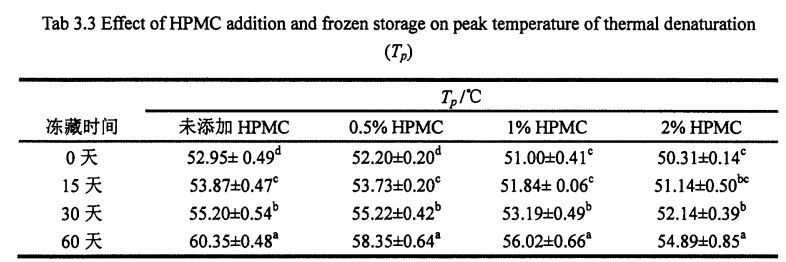
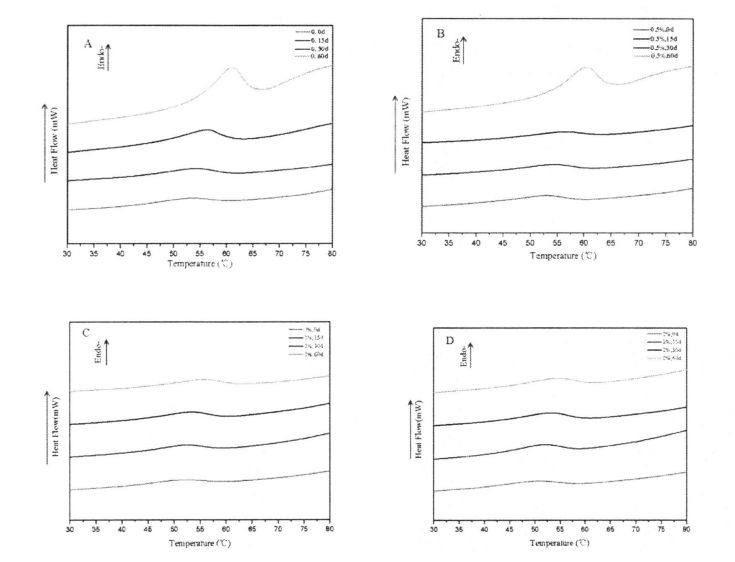
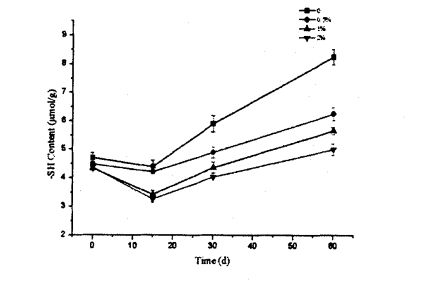
Gbr 3, épék Salaku neundeun HPMC sareng neundeun beku kana eusi gratis-péso dieusian di luhur, cai anu sepuh tiasa ngabentuk kristal tina suhu gonden. Therefore, with the prolongation of freezing time, the ice crystals become larger, which squeezes the gluten protein structure more seriously, and leads to the breakage of some intermolecular and intramolecular disulfide bonds, which increases the content of free sulfhydryl groups. On the other hand, the experimental results show that HPMC can protect the disulfide bond from the extrusion damage of ice crystals, thereby inhibiting the depolymerization process of gluten protein. 3.3.4 Effects of HPMC addition amount and freezing storage time on transverse relaxation time (T2) of wet gluten mass The distribution of Transverse Relaxation Time (T2) can reflect the model and dynamic process of water migration in food materials [6]. Figure 3.4 shows the distribution of wet gluten mass at 0 and 60 days with different HPMC additions, including 4 main distribution intervals, namely 0.1.1 ms (T21), 1.10 ms (T22), 10.100 ms (dead;) and 1 00-1 000 ms (T24). Bosmans et al. (2012) found a similar distribution of wet gluten mass [1261], and they suggested that protons with relaxation times below 10 ms could be classified as rapidly relaxing protons, which are mainly derived from poor mobility the bound water, therefore, may characterize the relaxation time distribution of bound water bound to a small amount of starch, while Dang may characterize the relaxation time distribution of bound water bound to gluten protein. In addition, Kontogiorgos (2007) - t11¨, the "strands" of the gluten protein network structure are composed of several layers (Sheets) about 5 nm apart, and the water contained in these layers is limited water (or Bulk water, phase water), the mobility of this water is between the mobility of bound water and free water. And T23 can be attributed to the relaxation time distribution of restricted water. The T24 distribution (>100 ms) has a long relaxation time, so it characterizes free water with strong mobility. This water exists in the pores of the network structure, and there is only a weak capillary force with the gluten protein system.
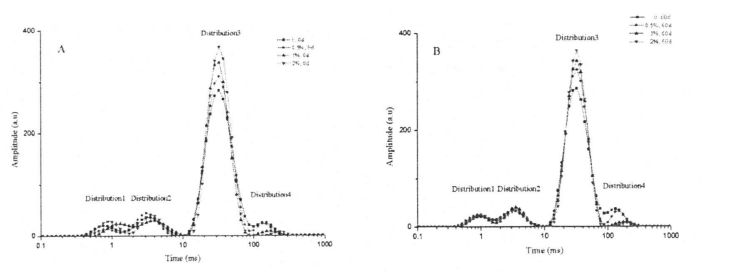
Atribusi sareng sebutan didaptarkeun dina Méja 3.4.
Tab 3.4 posisi puncak sareng tugas struktur sekundér asalna tina ami iii di Spectre FT

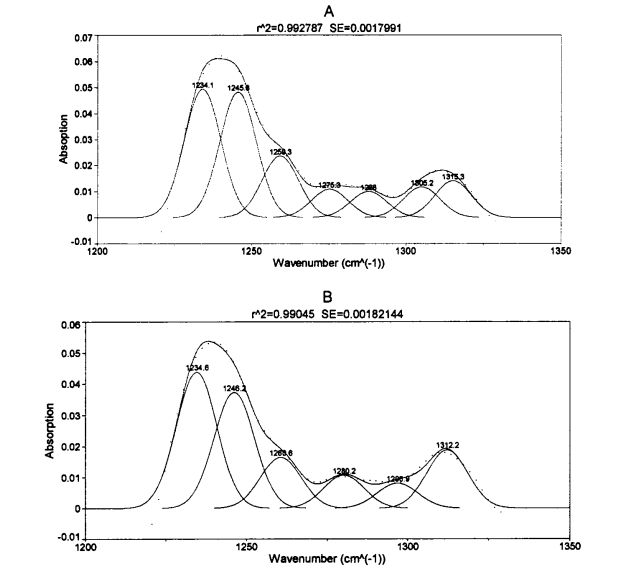
Note: A is the infrared spectrum of wheat gluten protein without adding HPMC for 0 days of frozen storage; B nyaéta spéktrum inframed tina protéin gluten tina panyimpen beku pikeun 0 dinten sareng 2% HPMC
changed. Sababaraha paneliti percaya yén kanaékna eusi relatif struktur anu tip-jinisna bakal ngakibatkeun paningkatan dina hikigiity sareng hidroftroditas sanésna dijantenkeun p. The increase in folded structure is due to part of the new β-Fold formation is accompanied by a weakening of the structural strength maintained by hydrogen bonding [421]. β- The increase in the folded structure indicates that the protein is polymerized through hydrophobic bonds, which is consistent with the results of the peak temperature of thermal denaturation measured by DSC and the distribution of transverse relaxation time measured by low-field nuclear magnetic resonance. Protein denaturation. On the other hand, added 0.5%, 1% and 2% HPMC gluten protein α-whirling. The relative content of helix increased by 0.95%, 4.42% and 2.03% respectively with the prolongation of freezing time, which is consistent with Wang, et a1. (2014) found similar results [134]. 0 of gluten without added HPMC. There was no significant change in the relative content of helix during the frozen storage process, but with the increase of the addition amount of freeze for 0 days. Aya bédana anu signifikan dina eusi relatif tina struktur α-whiring.
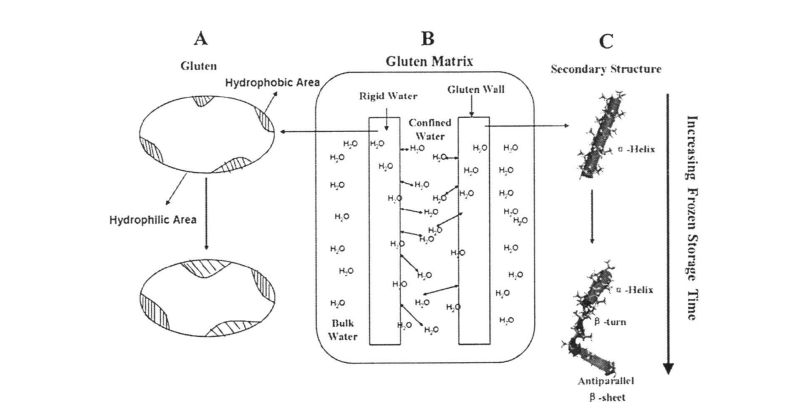
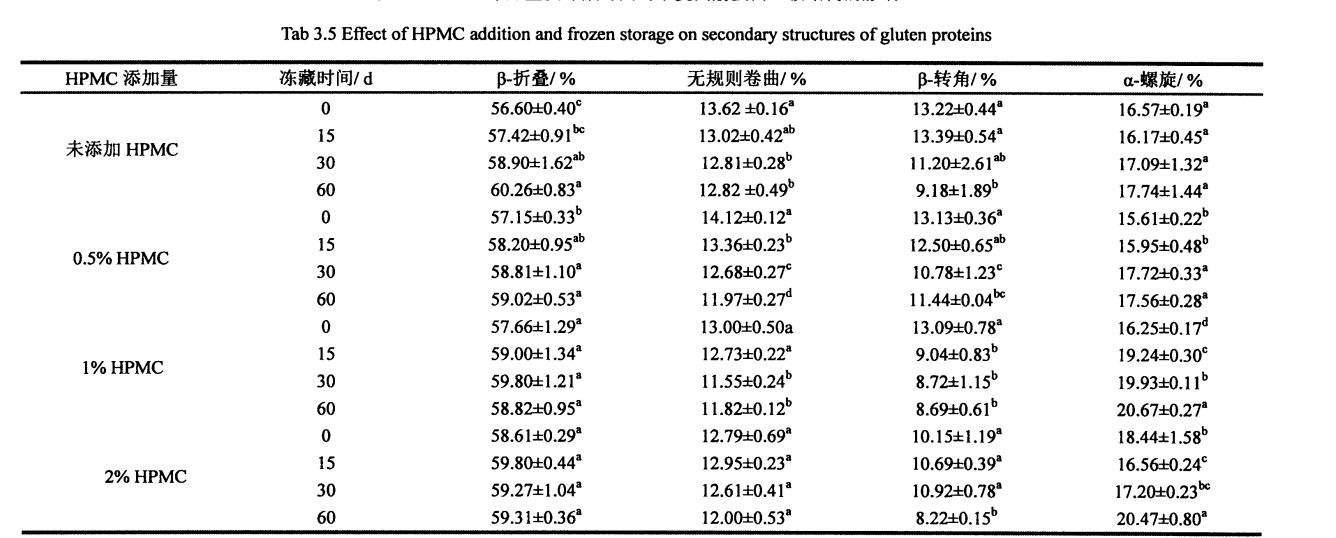
Protein molecules include both hydrophilic and hydrophobic groups. Generally, the protein surface is composed of hydrophilic groups, which can bind water through hydrogen bonding to form a hydration layer to prevent protein molecules from agglomerating and maintain their conformational stability. The interior of the protein contains more hydrophobic groups to form and maintain the secondary and tertiary structure of the protein through the hydrophobic force. Dénaturasi protéin sering dipirig ku kiriman kelompok hidrofobic sareng tambah hidroftricity permukaan.

3.3.7 Keuntungan HPMC Enstas sareng Free Freezing Dina Struktur Netro-jaringan Gluten
The continuous gluten network structure contains many pores to maintain the carbon dioxide gas produced by the yeast during the proofing process of the dough. Therefore, the strength and stability of the gluten network structure are very important to the quality of the final product, such as specific volume, quality, etc. Structure and sensory assessment. Tina sudut pandutan mikro, peurma permukaan bahan anu tiasa dititina ku kecahan éléktron éléktron éléktron, anu nyayogikeun akurat pikeun nyusun struktur data Gluten saluran.
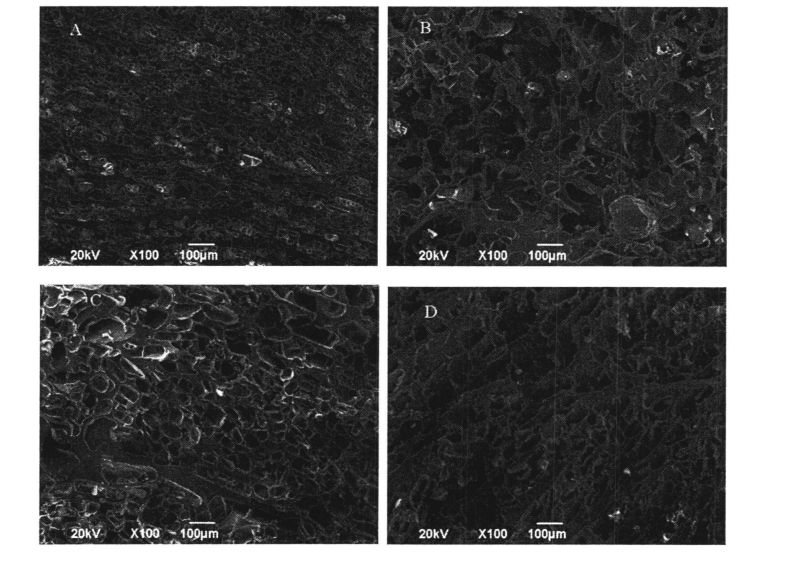
Leutik perkiraan morfologi However, after 60 days of frozen storage, the cells in the gluten microstructure without HPMC became larger in size, irregular in shape, and unevenly distributed (Fig. 3.7, A, B), mainly due to the This is caused by the fracture of the "wall", which is consistent with the measurement results of the free thiol group content, that is, during the freezing process, the ice crystal squeezes and breaks the disulfide bond, which affects the strength and integrity of the structure. As reported by Kontogiorgos & Goff (2006) and Kontogiorgos (2007), the interstitial regions of the gluten network are squeezed due to freeze-shrinkage, resulting in structural disruption [138. 1391]. In addition, due to dehydration and condensation, a relatively dense fibrous structure was produced in the spongy structure, which may be the reason for the decrease in free thiol content after 15 days of frozen storage, because more disulfide bonds were generated and frozen storage. The gluten structure was not severely damaged for a shorter time, which is consistent with Wang, et a1. (2014) observed similar phenomena [134]. At the same time, the destruction of the gluten microstructure leads to freer water migration and redistribution, which is consistent with the results of low-field time-domain nuclear magnetic resonance (TD-NMR) measurements. Some studies [140, 105] reported that after several freeze-thaw cycles, the gelatinization of rice starch and the structural strength of the dough became weaker, and the water mobility became higher. Nonetheless, after 60 days of frozen storage, the microstructure of gluten with 2% HPMC addition changed less, with smaller cells and more regular shapes than gluten without HPMC addition (Fig. 3.7, B, D). This further indicates that HPMC can effectively inhibit the destruction of gluten structure by recrystallization.
Élos Éksperimén ieu nalungtik rélologi adonan gluten baseuh sareng protéin glutén ku nambihan HPMC sareng eusi anu béda (0% sareng payun, 15, 30 dinten). properties, thermodynamic properties, and effects of physicochemical properties. The study found that the change and redistribution of water state during the freezing storage process significantly increased the freezable water content in the wet gluten system, which led to the destruction of the gluten structure due to the formation and growth of ice crystals, and ultimately caused the processing properties of the dough to be different. Deterioration of product quality. The results of frequency scanning showed that the elastic modulus and viscous modulus of the wet gluten mass without adding HPMC decreased significantly during the freezing storage process, and the scanning electron microscope showed that its microstructure was damaged. The content of free sulfhydryl group was significantly increased, and its hydrophobic group was more exposed, which made the thermal denaturation temperature and surface hydrophobicity of gluten protein significantly increased. However, the experimental results show that the addition of I-IPMC can effectively inhibit the changes in the structure and properties of wet gluten mass and gluten protein during freezing storage, and within a certain range, this inhibitory effect is positively correlated with the addition of HPMC. This is because HPMC can reduce the mobility of water and limit the increase of the freezable water content, thereby inhibiting the recrystallization phenomenon and keeping the gluten network structure and the spatial conformation of the protein relatively stable. This shows that the addition of HPMC can effectively maintain the integrity of the frozen dough structure, thereby ensuring product quality.
Among them, starch gelatinization refers to the process in which starch granules are gradually disintegrated and hydrated in a system with high water content and under heating conditions. It can be roughly divided into three main processes. 1) Reversible water absorption stage; before reaching the initial temperature of gelatinization, the starch granules in the starch suspension (Slurry) keep their unique structure unchanged, and the external shape and internal structure basically do not change. Only very little soluble starch is dispersed in the water and can be restored to its original state. 2) The irreversible water absorption stage; as the temperature increases, water enters the gap between the starch crystallite bundles, irreversibly absorbs a large amount of water, causing the starch to swell, the volume expands several times, and the hydrogen bonds between the starch molecules are broken. Éta janten luh sareng kristal ngaleungit. At the same time, the birefringence phenomenon of starch, that is, the Maltese Cross observed under a polarizing microscope, begins to disappear, and the temperature at this time is called the initial gelatinization temperature of starch. 3,) Pelukaan Gatular Gatular; Molecul écompait lengkep aksés sistem solusi pikeun nyusun témpél pati (témpél / Tatét Penget), dina waktos ayeuna viscenisasi sacara visuis ogé disebut α). When the dough is cooked, the gelatinization of starch endows the food with its unique texture, flavor, taste, color, and processing characteristics.
Sacara umum, Gelatination Gelatination kapangaruhan ku sumber sareng jinis aci, a empit hasyose sareng amylectione, jsin sacara éksprési sareng kaayaan kutipan eusi uyah, sareng kaayaan panyingkaran, sareng kaayaan épision,. Therefore, when the structure of starch (surface morphology, crystalline structure, etc.) is changed, the gelatinization properties, rheological properties, aging properties, digestibility, etc. of starch will be affected accordingly.
Many studies have shown that the gel strength of starch paste decreases, it is easy to age, and its quality deteriorates under the condition of freezing storage, such as Canet, et a1. (2005) Di sabagian suhu katirisan dina kualitas pati murte caur; Ferrero, et A1. (1993) investigated the effects of freezing rate and different types of additives on the properties of wheat and corn starch pastes [151-156]. However, there are relatively few reports on the effect of frozen storage on the structure and properties of starch granules (native starch), which needs to be further explored. Frozen dough (excluding pre-cooked frozen dough) is in the form of ungelatinized granules under the condition of frozen storage. Therefore, studying the structure and structural changes of native starch by adding HPMC has a certain effect on improving the processing properties of frozen dough. significance.
Patokan gandum binzhou zhongyu kadaharan co., ltd.; HPMC Aladdin (Shanghai) Kimia Re., LTD.;
Produsén
(1) persiapan sampel
Candak 2,5 g amyoo sareng nyampur kalayan cai sulingan dina nisbah 1: 2 supados ngadamel susu pati. Freeze at 18°C for 15 d, 30 d, and 60 d. Add 0.5, 1, 2% HPMC (w/w) to replace starch of the same quality, and other preparation methods remain unchanged. After the freezing treatment is completed, take it out, equilibrate at 4 °C for 4 h, and then thaw at room temperature until it is tested.
(3) kakuatan gél (kakuatan gél)
A layer of petrolatum was lightly applied to the edge of the starch gel obtained above to avoid water loss during subsequent experiments. Ngarujuk kana metode AbeBe & Ronalyah [1601], Lembur galur oscill écill parantos dilakukeun ku tegalan viscopatyat lorong na, sareng sapuleud ieu 1 Eme 6 ° C.
(1) persiapan sampel
(3) tekad suhu gelatinzal sareng robih enttalpy
4.2.3.5 Ukuran Xrd
All experiments were repeated at least three times unless otherwise specified, and the experimental results were expressed as mean and standard deviation. Janten statistik 19 dipaké pikeun nganalisa varian (analisa varian, Anova) kalayan tingkat signifikan 0.05; Bagan korélasi ditarik nganggo asal 8,0.

Méja 4.2 daptar prosés sababaraha indikasi penting ciri gelatinisasi aci, kalebet Verisous Pesserization Maryamess, nilai viscai sareng nilai kekirian sareng témpél pati teras. effects of chemical properties. The experimental results show that the peak viscosity, the minimum viscosity and the final viscosity of starch without frozen storage increased significantly with the increase of HPMC addition, while the decay value and recovery value decreased significantly. Specifically, the peak viscosity gradually increased from 727.66+90.70 CP (without adding HPMC) to 758.51+48.12 CP (adding 0.5% HPMC), 809.754-56.59 CP (adding 1 %HPMC), and 946.64+9.63 CP (adding 2% HPMC); the minimum viscosity was increased from 391.02+18.97 CP (blank not adding) to 454.95+36.90 (adding O .5% HPMC), 485.56+54.0.5 (add 1% HPMC) and 553.03+55.57 CP (add 2% HPMC); the final viscosity is from 794.62.412.84 CP ( Without adding HPMC) increased to 882.24±22.40 CP (adding 0.5% HPMC), 846.04+12.66 CP (adding 1% HPMC) and 910.884-34.57 CP (adding 2 %HPMC); however, the attenuation value gradually decreased from 336.644-71.73 CP (without adding HPMC) to 303.564-11.22 CP (adding 0.5% HPMC), 324.19±2.54 CP (Add
Kalayan 1% HPMC) sareng 393.614-45.94 CP (kalayan 2% HPMC), nilai mprogranson tambah) sareng 427 CP Aturan) sareng 427 CP Atang '. 357.85+21.00 CP (2% HPMC added). Ieu sareng tambahan hidrokolloid sapertos xanthan gum sareng gurun dieusian ku achowhakika & Suphantharika (2008) sareng Huang (2009) tiasa ningkatkeun viskositas acuk bari ngirangan exclorasi. Ieu sanés utamina sabab HPMC salaku kolékkeun koloklat hidrofilik, teras tambahan ningkatkeun gelmiositas caian dina suhu pati. In addition, the temperature range of the thermal gelatinization process (thermogelation process) of HPMC is larger than that of starch (results not shown), so that the addition of HPMC can effectively suppress the drastic decrease in viscosity due to the disintegration of starch granules. Therefore, the minimum viscosity and final viscosity of starch gelatinization increased gradually with the increase of HPMC content.

(Frozen storage for 0 days) increased to 1198.09 ± 41.15 CP (frozen storage for 60 days). Correspondingly, the attenuation value of starch suspension without adding HPMC increased from 336.64 ± 71.73 CP (frozen storage for 0 days) to 1027.67 ± 38.72 CP (frozen storage for 60 days); adding 0.5 The attenuation value of starch suspension with %HPMC increased from 303.56±11.22 CP (frozen storage for 0 days) to 833.9±26.45 CP (frozen storage for 60 days); starch suspension with 1% HPMC added The attenuation value of the liquid was increased from 324.19 ± 2.54 CP (freezing for 0 days) to 672.71 ± 10.96 CP (freezing for 60 days); while adding 2% HPMC,the attenuation value of the starch suspension increased from 393.61 ± 45.94 CP (freezing for 0 days) to 557.64 ± 73.77 CP (freezing for 60 days); Nalika gantung lebuna tanpa HPMC nambihan nilai acuk mundur tina 403.60 ± 6,13 c
P (frozen storage for 0 days) to 856.38 ± 16.20 CP (frozen storage for 60 days); the retrogradation value of starch suspension added with 0.5% HPMC increased from 427 .29±14.50 CP (frozen storage for 0 days) increased to 740.93±35.99 CP (frozen storage for 60 days); the retrogradation value of starch suspension added with 1% HPMC increased from 360.48±41. 39 CP (frozen storage for 0 days) increased to 666.46 ± 21.40 CP (frozen storage for 60 days); while the retrogradation value of starch suspension added with 2% HPMC increased from 357.85 ± 21.00 CP (frozen storage for 60 days). 0 dinten) ningkat ka 515.51 ± 20.86 CP (60 dinten beku).



On the other hand, for the starch without frozen storage, its K value decreased significantly with the addition of HPMC, from 78.240±1.661 Pa ·sn (without adding HPMC) to 65.240±1.661 Pa ·sn (without adding HPMC), respectively. 683±1.035 Pa ·sn (add 0.5% Hand MC), 43.122±1.047 Pa ·sn (add 1% HPMC), and 13.926±0.330Pa·Sn (add 2% HPMC), while the n value increased significantly, from 0.277 ± 0.011 (without adding HPMC) to 0.277 ± 0.011 in turn. 310 ± 0.009 (add 0.5% HPMC), O. 323 ± 0.013 (add 1% HPMC) and O. 43 1 ± 0.0 1 3 (adding 2% HPMC), which is similar to the experimental results of Techawipharat, Suphantharika, & BeMiller (2008) and Turabi, Sumnu, & Sahin (2008), and the increase of n value nunjukkeun yén adaptasi hpmc ngajadikeun cairan ngagaduhan kacenderungan pikeun ngarobih tina pseudlastas kana newtonian [168'1691]. Dina waktos anu sami, kana aci disimpen salami 60 dinten, KK, nilai nunjukkeun aturan parobahan anu sami sareng kanaékan tambahan HPMC.
However, with the prolongation of freezing storage time, the values of K and n increased to different degrees, among which the value of K increased from 78.240 ± 1.661 Pa·sn (unadded, 0 days) to 95.570 ± 1, respectively. 2.421 Pa·sn (no addition, 60 days), increased from 65.683±1.035 Pa ·S n (addition of O. 5% HPMC, 0 days) to 51.384±1.350 Pa ·S n (Add to 0.5% HPMC, 60 days), increased from 43.122±1.047 Pa ·sn (adding 1% HPMC, 0 days) to 56.538±1.378 Pa ·sn (adding 1% HPMC, 60 days) ), and increased from 13.926 ± 0.330 Pa ·sn (adding 2% HPMC, 0 days) to 16.064 ± 0.465 Pa ·sn (adding 2% HPMC, 60 days); 0.277 ± 0.011 (without adding HPMC, 0 days) rose to O. 334±0.014 (no addition, 60 days), increased from 0.310±0.009 (0.5% HPMC added, 0 day) to 0.336±0.014 (0.5% HPMC added, 60 days), from 0.323 ± 0.013 (add 1% HPMC, 0 days) to 0.340 ± 0.013 (add 1% HPMC, 60 days), and from 0.431 ± 0.013 (add 1% HPMC, 60 days) 2% HPMC, 0 days) to 0.404+0.020 (add 2% HPMC, 60 days). By comparison, it can be found that with the increase of the addition amount of HPMC, the change rate of K and Knife value decreases successively, which shows that the addition of HPMC can make the starch paste stable under the action of shearing force, which is consistent with the measurement results of starch gelatinization characteristics. konsisten.
4.3.4 Balukaan HPMC tambahan sareng waktos panyimpen anu beku dina viscoelastik dinamis témpél pati

The swelling ratio of starch can reflect the size of starch gelatinization and water swelling, and the stability of starch paste under centrifugal conditions. As shown in Figure 4.4, for starch without frozen storage, with the increase of HPMC addition, the swelling force of starch increased from 8.969+0.099 (without adding HPMC) to 9.282- -L0.069 (adding 2% HPMC), which shows that the addition of HPMC increases the swelling water absorption and makes starch more stable after gelatinization, which is consistent with the conclusion of starch gelatinization characteristics. Nanging, ku pangaliran waktos beku beku, kakuatan jembar aci turun. Compared with 0 days of frozen storage, the swelling power of starch decreased from 8.969-a:0.099 to 7.057+0 after frozen storage for 60 days, respectively. .007 (no HPMC added), reduced from 9.007+0.147 to 7.269-4-0.038 (with O.5% HPMC added), reduced from 9.284+0.157 to 7.777 +0.014 (adding 1% HPMC), reduced from 9.282+0.069 to 8.064+0.004 (adding 2% HPMC). Hasilna nunjukkeun yén gandum pati ruksak saatos ditip dangkal dina kaayaan présipasi, hasilna tina présipitasi pati bijil sareng centrifation. Therefore, the solubility of starch increased and the swelling power decreased. In addition, after freezing storage, starch gelatinized starch paste, its stability and water holding capacity decreased, and the combined action of the two reduced the swelling power of starch [1711]. On the other hand, with the increase of HPMC addition, the decline of starch swelling power gradually decreased, indicating that HPMC can reduce the amount of damaged starch formed during freezing storage and inhibit the degree of starch granule damage.
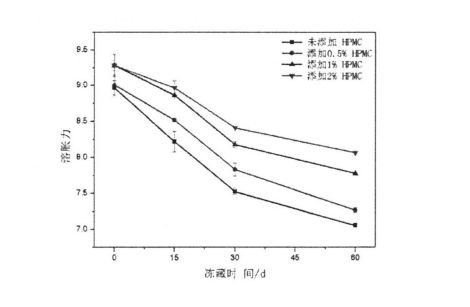
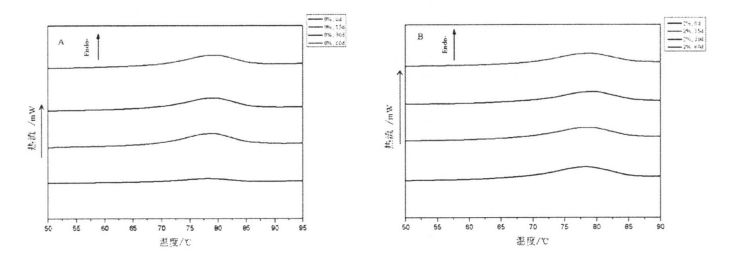
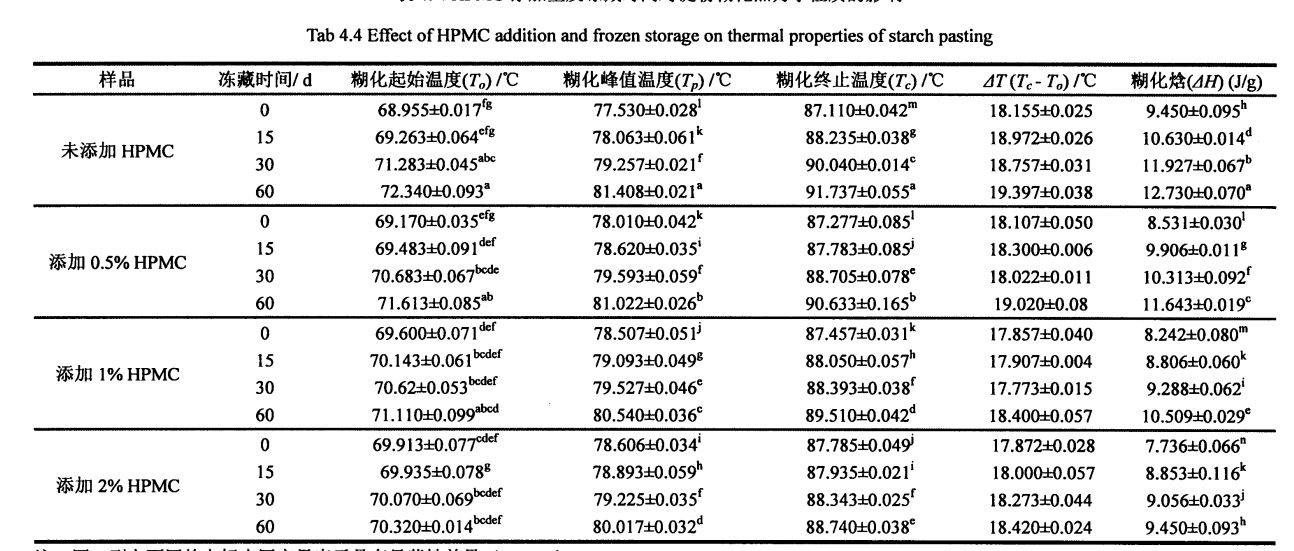
4.3.7 épék umat IPMC tambahan sareng freeed freezate dina kristal relatif aci
X. X-ray diffraction (XRD) is obtained by X. X-ray diffraction is a research method that analyzes the diffraction spectrum to obtain information such as the composition of the material, the structure or morphology of the atoms or molecules in the material. Kusabab nagara acars ngagaduhan struktur kristal, xrd sering biasa nganalkeun sareng masihan bentuk kristal sareng kristalasi genalitas kristal.
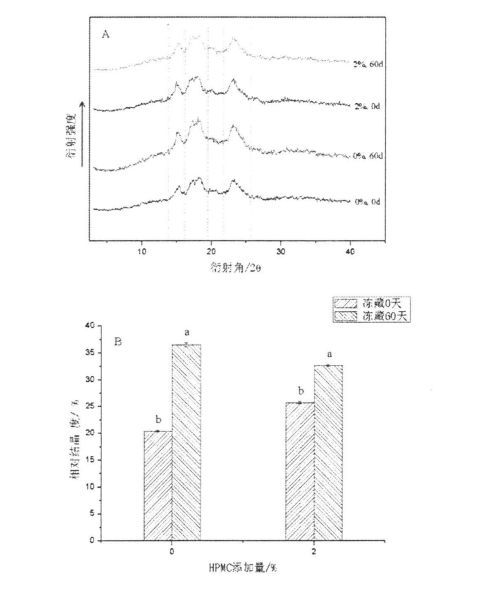
Note: A is x. Spikf fluraction sinum; B is the relative crystallinity result of starch;
SP. Modél 754 UV spéktropometer
Produsén
Weigh 3 g of active dry yeast, add it to a sterilized 50 mL centrifuge tube under aseptic conditions, and then add 27 mL of 9% (w/V) sterile saline to it, shake it up, and prepare 10% (w/w) yeast broth. Then, quickly move to. Simpen dina kulkas di 18 ° C. Sanggeus 5 d, 30 d, sareng 60 d neundeunken, sampelna dicandak tetep coba. Tambahkeun 0,5%, 1%, 2% HPMC (W / W) pikeun ngagentos persentase garing anu cocog. In particular, after the HPMC is weighed, it must be irradiated under an ultraviolet lamp for 30 minutes for sterilization and disinfection.
Cara Allusoxan dipaké pikeun nangtukeun eusi glutathye. The principle is that the reaction product of glutathione and alloxan has an absorption peak at 305 nl. Specific determination method: pipette 5 mL of yeast solution into a 10 mL centrifuge tube, then centrifuge at 3000 rpm for 10 min, take 1 mL of supernatant into a 10 mL centrifuge tube, add 1 mL of 0.1 mol/mL to the tube L alloxan solution, mixed thoroughly, then add 0.2 M PBS (pH 7.5) and 1 mL of 0.1 M, NaOH solution to it, mix well, let stand for 6 min, and immediately add 1 M, NaOH The solution was 1 mL, and the absorbance at 305 nm was measured with a UV spectrophotometer after thorough mixing. The glutathione content was calculated from the standard curve. Each sample was paralleled three times.

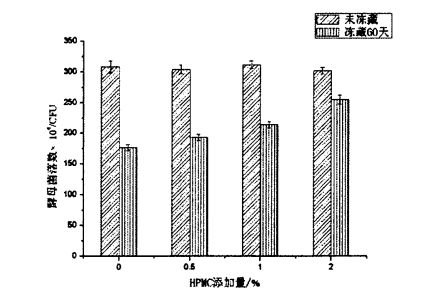
It can be seen from Figure 5.2 that there is no significant difference in the number of yeast colonies in samples with different contents of HPMC added without freezing treatment. Ieu mirip sareng hasil ditangtukeun ku Heitmann, Zannini, teras Arendt (2015) [180]. However, after 60 days of freezing, the number of yeast colonies decreased significantly, from 3.08x106 CFU to 1.76x106 CFU (without adding HPMC); from 3.04x106 CFU to 193x106 CFU (adding 0.5% HPMC); diréduksi ti 3.12x106 cfu ka 2.14x106 CFU (tambah 1% HPMC); diréduksi tina 3.02x106 cfu dugi ka 2,55x106 CFU (tambah 2% HPMC). By comparison, it can be found that the freezing storage environment stress led to the decrease of the yeast colony number, but with the increase of HPMC addition, the degree of the decrease of the colony number decreased in turn. This indicates that HPMC can better protect yeast under freezing conditions. The mechanism of protection may be the same as that of glycerol, a commonly used strain antifreeze, mainly by inhibiting the formation and growth of ice crystals and reducing the stress of low temperature environment to yeast. Figure 5.3 is the photomicrograph taken from the 3M yeast rapid counting test piece after preparation and microscopic examination, which is in line with the external morphology of yeast.
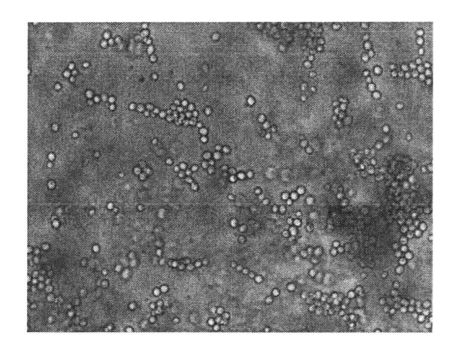
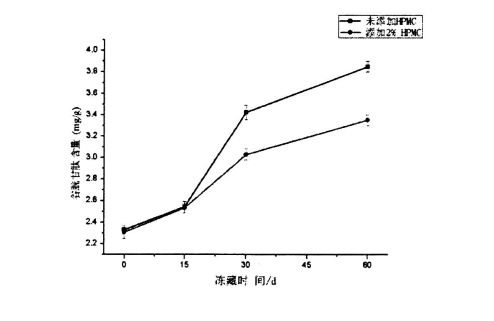
Gratis 94 épék tambahan HPMC sareng neundeun beku dina eusi glutathione (gsh)
As shown in Figure 5.4, the glutathione content increased regardless of whether HPMC was added or not, and there was no significant difference between the different addition amounts. Ieu tiasa kusabab sababaraha kapang garing anu aktip dipaké pikeun ngajantenkeun adonan anu gaduh résistan stres anu kirang sareng kaségingan. Under the condition of low temperature freezing, the cells die, and then glutathione is released, which is only related to the characteristics of the yeast itself. Katinggal pakait sareng lingkungan éksternal, tapi teu aya hubunganana sareng jumlah HPMC tambah. Therefore, the content of glutathione increased within 15 days of freezing and there was no significant difference between the two. However, with the further extension of the freezing time, the increase of glutathione content decreased with the increase of HPMC addition, and the glutathione content of the bacterial solution without HPMC was increased from 2.329a: 0.040mg/ g (frozen storage for 0 days) increased to 3.8514-0.051 mg/g (frozen storage for 60 days); while the yeast liquid added 2% HPMC, its glutathione content increased from 2.307+0 .058 mg/g (frozen storage for 0 days) rose to 3.351+0.051 mg/g (frozen storage for 60 days). This further indicated that HPMC could better protect yeast cells and reduce the death of yeast, thereby reducing the content of glutathione released to the outside of the cell. Hal ieu anggaran sabab HPMC tiasa ngirangan jumlah krical és, aya sacara efektif ngalungkeun settiprat és.
Waktu Pasang: Oktober10222







